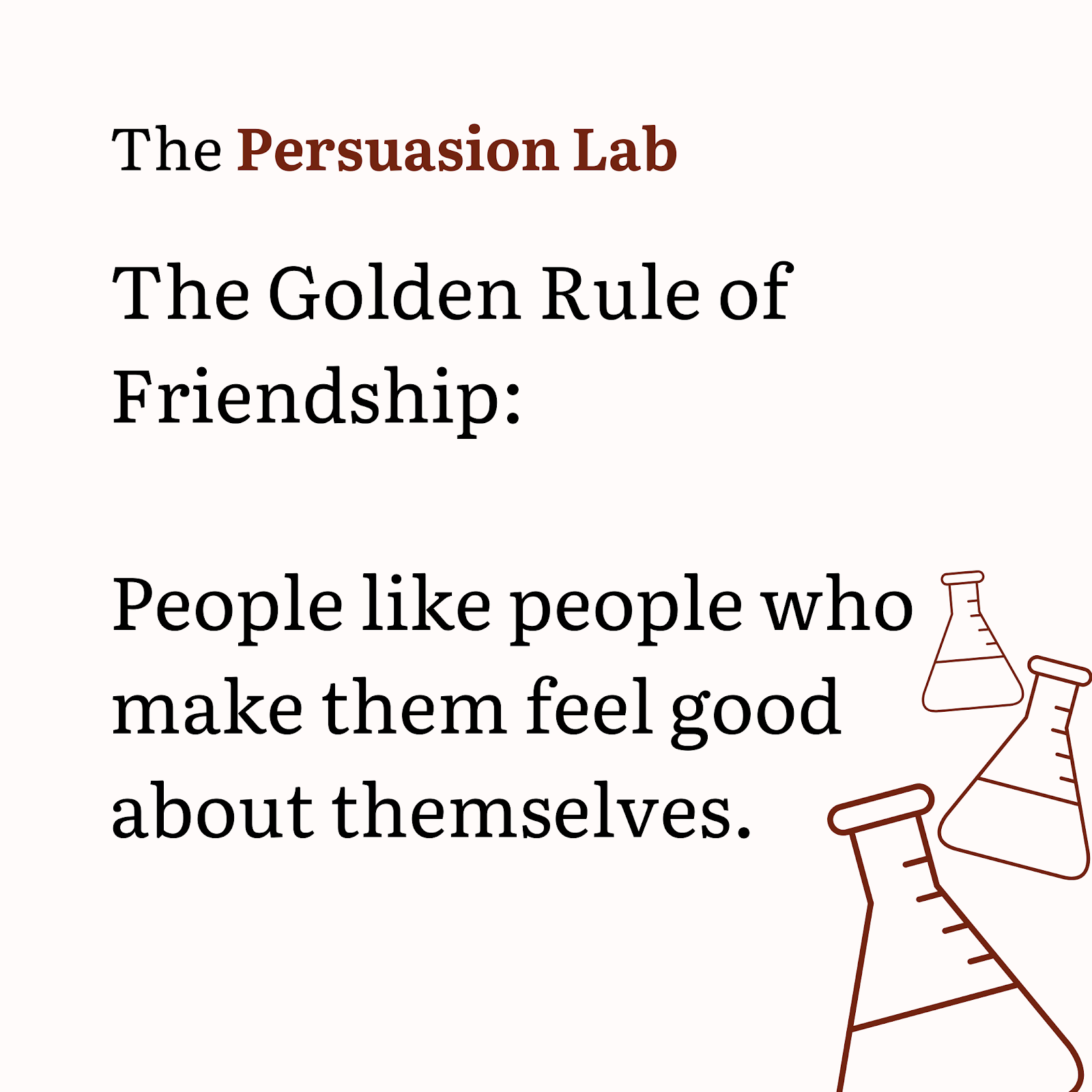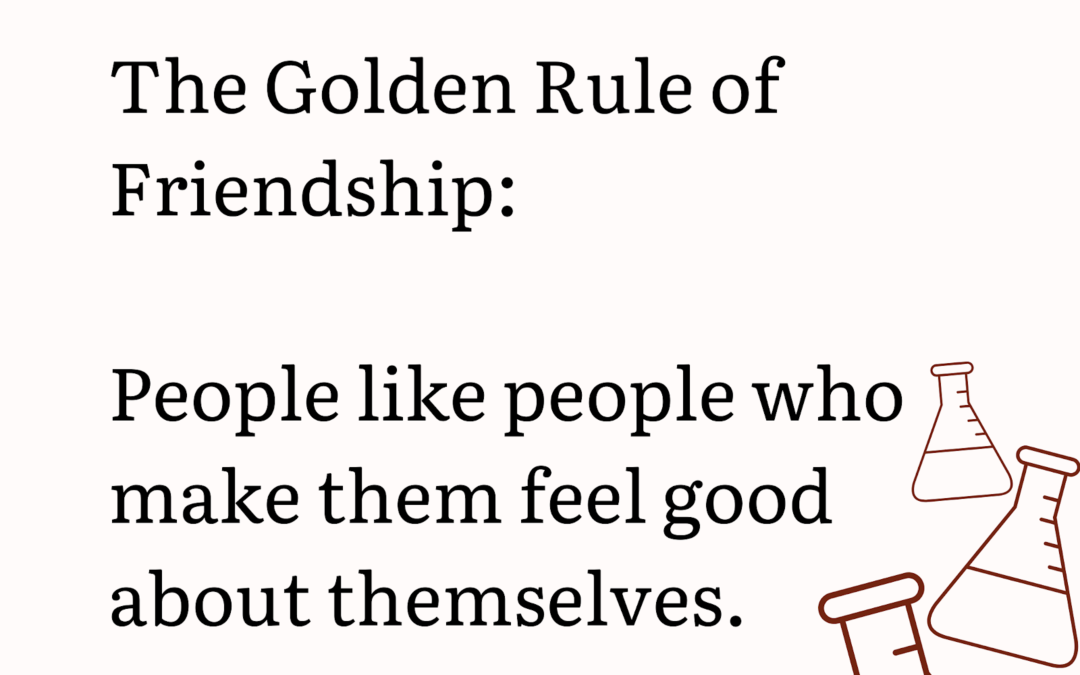TL;DR — People work hard with and for folks they like. People like people who make them feel good about themselves. To persuade under pressure, your job is to listen (trust me, the time spent listening will be saved later on), which will make folks feel good about themselves, and more likely to do what you’d like.
What follows is the nuance of why this is, and clear, concrete steps to make it work for you.
You know the golden rule, but do you know the “Golden Rule of Friendship”? A concept developed by Jack Schafer, PhD, the golden rule of friendship states that people like people who make them feel good about themselves.
Imagine you’re meeting a new professional contact virtually, mostly as a favor to a colleague. That person shows up on time, asks thoughtful questions about who you are and what you do, and cites an obscure fact from your LinkedIn profile they relate to. Maybe they ask to be included in an email blast for a new product or service that’s listed on your website as ‘Coming Soon!’.
How do you feel about this person? How likely are you to do them a favor like making an introduction or providing some feedback?
Imagine you’re meeting another professional contact virtually, again, mostly as a favor to a colleague. The person shows up late. They have no idea what you do, and maybe even struggle to remember your name.
How do you feel about this person? How likely are you to do them a favor like making an introduction or providing some feedback?
You’re probably fairly likely to help out that first contact — they’ve done all the right things to make you feel good about yourself. They’ve showed up with thoughtful attention to who YOU are and the value you provide.
That second contact… not so much.
If in 15 minutes or so you can be persuaded — simply by feeling positively towards someone — to do something, how much more powerful to cultivate these same feelings within your team?
Not unlike planting a tree, the best time to cultivate a sense of goodwill and value among team members is years ago. The second best time is now. The worst time is when you’re already under time or financial pressure.
As a founder, team leader, or upper manager, your job is to listen to and empower your employees and team members.
We like to think that people turn into hyper-rational beings in crisis. Urgency should lead to better performance, right?
Not so much.

In a crisis, getting everyone motivated and on the same page can be a crisis in and of itself, thanks to neurobiology and shut-down of the logical, thinking centers of the brain.
Of course, crisis states in business happen for any number of reasons: unforeseen competition, new regulations, short deadlines, new and complex requests from anchor clients on short notice, production problems, a key team member or player is behind on a project component, unannounced executive departure, someone out sick, pandemic… you’ve lived in 2020, you get it.
Ironically, the best way to counter a shutdown of logical thinking is to leverage emotional know how. Taking time to check in with team members and listen will pay back dividends both in loyalty, creativity, and productivity.
Remember, people like people who make them feel good, and being listened to and empowered makes people feel good.
Here’s how to make the magic happen.
Step 1: Stop Talking! This sounds silly… and it is. Obviously, to listen, you need to stop talking. AND pay attention to how often you interrupt someone when they are speaking. If you catch yourself jumping in — STOP! Shut your mouth and refocus on what the other person is saying.
Step 2: Strive to Understand, not Respond. Get curious. Ask questions. Sometimes folks just need to say what’s going on. The better you understand what’s going on with the other person, the more easily you can both come up with a solution and get to fast tracking it.
Step 3: Repeat Back/Summarize. Memorize this sentence starter: “So what I’m hearing is _______.” After you’ve gathered all the information, use this structure to summarize. “So what I’m hearing is that there’s a breakdown in scheduling real-time communication between team members. ” At this point, the other person can correct you if you got it wrong, and then you can re-summarize again.
Step 4: Offer 2-3 Acceptable Solutions as Choices. If you have kids, you may have employed this strategy: “do you want an apple or a banana?” rather than “what would you like to eat?”
In business, the questions change but the concept remains the same. “Would a weekly or bi-weekly 15 minute meeting be sufficient?” Of course, the options must be acceptable to YOU as a team leader or supervisor. For example, don’t offer telework if that is not a viable option for your company, or if you cannot potentially offer it to everyone on the team.
Practice this style of communication when your team is in a steady state in order to become proficient; see if the team dynamics shift for the better as you practice this clear and straightforward system. Once you have the routine down, if and when crisis strikes, it will take a surprisingly short time to bring employees around to where they need to be in terms of getting the right work done on time.

